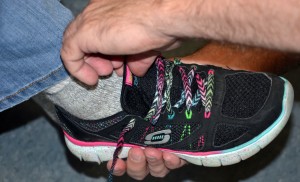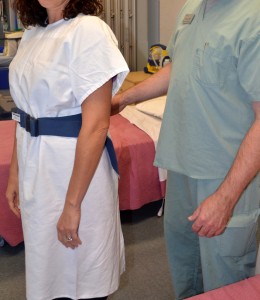Fall Prevention a Contract With Patients and Families
Affiliate iii. Safe Patient Treatment, Positioning, and Transfers
three.viii Fall Prevention
Patient falls are the most reported patient safety events in British Columbia and account for 40% of all agin events (BCPSLS, 2015). Falls are a major priority in health intendance, and health care providers are responsible for identifying, managing, and eliminating potential hazards to patients. All patient-handling activities (positioning, transfers, and ambulation) pose a take a chance to patients and health care providers. Older adults may exist at increased hazard for falls due to impaired mental condition, decreased force, impaired balance and mobility, and decreased sensory perception (Titler, Shever, Kanak, Picone, & Qin, 2011). Other patients may be at risk due to gait problems, cerebral power, visual problems, urinary frequency, generalized weakness, and cognitive dysfunction. Specific treatments and medications may crusade hypotension or drowsiness, which increment a patient'southward run a risk for falls (Hook & Winchel, 2006).
Fall Prevention Strategies
All clients should exist assessed for risk factors, and necessary prevention measures should exist implemented as per bureau policy. Table 3.7 lists factors that bear on patient safe and general measures to preclude falls in health care.
Prior to ambulation consider the following risk factors:
| |||
Prevention Strategies | Safety Measures | ||
| Expect for fall risk factors in all patients. | Identifying specific factors helps yous implement specific preventive measures. Risk factors include age, weakness on 1 side, the use of a cane or walker, history of dizziness or lightheadedness, low blood pressure, and weakness. | ||
| Follow hospital guidelines for transfers. | Transfer guidelines provide a proficient baseline for further patient adventure assessments. | ||
| Orient patient to surroundings. | Orient patients to bed, surroundings, location of bathroom and call bong, and tripping hazards in the surrounding environment. | ||
| Answer call bells promptly. | Long wait times may encourage unstable patients to ambulate independently. | ||
| Ensure basic elimination and personal needs are met. | Provide opportunities for patients to utilise the bathroom and to ask for water, pain medication, or a coating. | ||
| Ensure patient has proper footwear and mobility aids. | Proper footwear prevents slips.  | ||
| Communicate with your patients. | Let patients know when you will be dorsum, and how y'all will help them ambulate | ||
| Keep bed in the lowest position for sedated, unconscious, or compromised patients. | This pace prevents injury to patients. | ||
| Avert using side rails when a patient is dislocated. | Side track may create a bulwark that tin can exist easily climbed and create a autumn risk situation for confused patients. | ||
| Proceed assistive devices and other commonly used items close by. | Let patients to access assistive devices chop-chop and safely. Items such as the call bell, water, and Kleenex should be kept close by, to avert whatsoever excessive reaching. | ||
| Information source: Accreditation Canada, 2014; Canadian Patient Safety Plant, 2015; Perry et al., 2014; Titler et al., 2011 | |||
Lowering a Patient to the Floor
A patient may fall while ambulating or being transferred from 1 surface to another. If a patient begins to fall from a standing position, do not endeavour to stop the fall or catch the patient. Instead, control the fall by lowering the patient to the flooring. Checklist 31 lists the steps to assisting a patient to the flooring to minimize injury to patient and wellness care provider (PHSA, 2010).
Disclaimer: Ever review and follow your hospital policy regarding this specific skill. | |||
Condom considerations:
| |||
Steps | Additional Data | ||
| i. If a patient starts to fall and you lot are shut by, move behind the patient and have one step dorsum. | Look and be attentive to cues if a patient is feeling empty-headed or weak.  | ||
| ii. Support the patient around the waist or hip area, or grab the gait belt. Bend your leg and place it in between the patient'southward legs. | Hand placement allows for a solid grip on the patient to guide the fall.  | ||
| iii. Slowly slide the patient downward your leg, lowering yourself at the same time. Always protect the head first. | Lowering yourself with the patient prevents back injury and allows you lot to protect the patient's head from hit the floor or hard objects.  | ||
| 4. Once the patient is on the floor, assess the patient for injuries prior to moving. | Assesses patient'due south ability, or need for boosted assist, to get off the floor.  | ||
| 5. Provide reassurance and seek assistance if required. | If required, stay with the patient and call out for help. | ||
| half-dozen. If patient is unable to get upwards off the flooring, use a mechanical elevator. | If patient still feels dizzy or weak, using a mechanical lift will prevent injury. | ||
| 7. Complete an incident report according to agency policy. | An incident report helps place and manage risks related to patient falls. | ||
| Data source: Perry et al., 2014; PHSA, 2010; Titler et al., 2011 | |||
Special considerations:
- Use a falls take chances assessment tool for all patients according to agency policy.
- Younger patients may not be aware of the effects of medication and treatments leading to dizziness and orthostatic hypotension.
- Inform patients and family unit members nearly the potential risks for falls in the hospital. If informed, people are more likely to call for assistance.
- Always ensure telephone call bell is in place. Many falls occur due to incontinence issues. The call bell allows patient and family to obtain assistance apace.
- If appropriate, educate patient nearly home maintenance and safety to prevent falls when returning dwelling house.
- Fall prevention is interdisciplinary. Proper communication by the care team is required to forestall falls.
Take this Lowering a Patient to the Floor grade for more information on lowering a falling patient to the floor.
Video 3.7
Watch the videoAssisted Autumn by Kim Morris, Thompson Rivers University.
- Name 4 autumn prevention strategies that will assist keep a patient safe when ambulating in the hospital.
- A patient is ambulating for the first time subsequently surgery. Is it safe to encourage the patient to ambulate independently?
- Many physiological risk factors tin be identified from a routine assessment. Name three risk factors and three prevention strategies to manage these risks. For example, if a patient has frequent toileting needs, a preventive activeness is to offer aid to the toilet every hour, and to ensure the phone call bell is inside reach at all times.
Additional Videos
Video iii.8
Scout the video How to Apply a Hammock Sling by Kim Morris, Thompson Rivers Academy.
Video three.nine
Sentinel the video How to Use a Hygiene Sling by Kim Morris, Thompson Rivers University.
Source: https://opentextbc.ca/clinicalskills/chapter/3-7-fall-prevention/
0 Response to "Fall Prevention a Contract With Patients and Families"
Postar um comentário